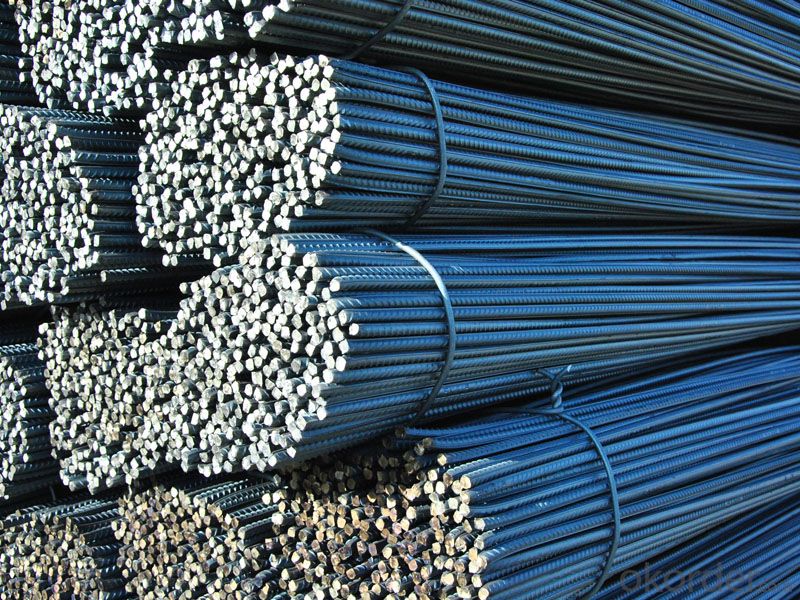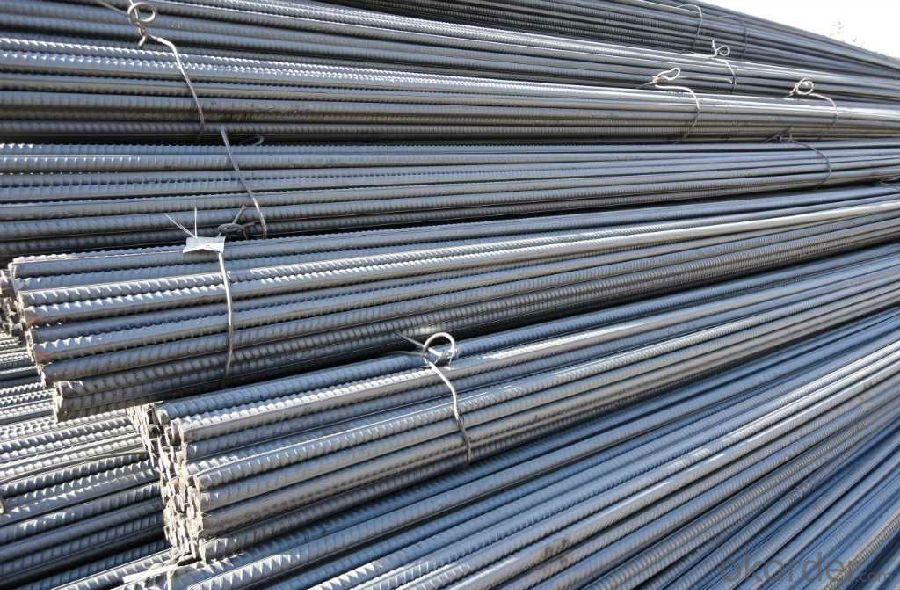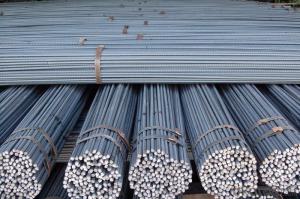Deformed bars Hot Rolled with High Quality and Good Price
- Loading Port:
- Tianjin
- Payment Terms:
- TT OR LC
- Min Order Qty:
- 25 m.t.
- Supply Capability:
- 10000 m.t./month
OKorder Service Pledge
OKorder Financial Service
You Might Also Like
Product Description:
OKorder is offering high quality Hot Rolled Rebars at great prices with worldwide shipping. Our supplier is a world-class manufacturer of steel, with our products utilized the world over. OKorder annually supplies products to Africa, North American and Asian markets. We provide quotations within 24 hours of receiving an inquiry and guarantee competitive prices.
Product Applications:
Deformed bar is widely used in buildings, bridges, roads and other engineering construction. Big to highways, railways, bridges, culverts, tunnels, public facilities such as flood control, dam, small to housing construction, beam, column, wall and the foundation of the plate, deformed bar is an integral structure material. With the development of world economy and the vigorous development of infrastructure construction, real estate, the demand for deformed bar will be larger and larger..
Label: to be specified by customer, generally, each bundle has 1-2 labels
Product Advantages:
OKorder's Hot Rolled Rebars are durable, strong, and resist corrosion.
Main Product Features:
· Premium quality
· Prompt delivery & seaworthy packing (30 days after receiving deposit)
· Corrosion resistance
· Can be recycled and reused
· Mill test certification
· Professional Service
· Competitive pricing
Product Specifications:
Manufacture: Hot rolled
Grade: HRB400 – HRB500
Certificates: ISO, SGS, BV, CIQ
Length: 6m – 12m, as per customer request
Packaging: Export packing, nude packing, bundled
Grade | Technical data of the original chemical composition (%) | ||||||
C | Mn | Si | S | P | V | ||
HRB400 | ≤0.25 | ≤1.60 | ≤0.80 | ≤0.045 | ≤0.045 | 0.04-0.12 | |
Physical capability | |||||||
Yield Strength (N/cm²) | Tensile Strength (N/cm²) | Elongation (%) | |||||
≥400 | ≥570 | ≥14 | |||||
Theoretical weight and section area of each diameter as below for your information:
Diameter(mm) | Section area (mm²) | Mass(kg/m) | Weight of 12m bar(kg) |
6 | 28.27 | 0.222 | 2.664 |
8 | 50.27 | 0.395 | 4.74 |
10 | 78.54 | 0.617 | 7.404 |
12 | 113.1 | 0.888 | 10.656 |
14 | 153.9 | 1.21 | 14.52 |
16 | 201.1 | 1.58 | 18.96 |
18 | 254.5 | 2.00 | 24 |
20 | 314.2 | 2.47 | 29.64 |
22 | 380.1 | 2.98 | 35.76 |
25 | 490.9 | 3.85 | 46.2 |
28 | 615.8 | 4.83 | 57.96 |
32 | 804.2 | 6.31 | 75.72 |
36 | 1018 | 7.99 | 98.88 |
40 | 1257 | 9.87 | 118.44 |
50 | 1964 | 15.42 | 185.04 |
FAQ:
Q1: Why buy Materials & Equipment from OKorder.com?
A1: All products offered byOKorder.com are carefully selected from China's most reliable manufacturing enterprises. Through its ISO certifications, OKorder.com adheres to the highest standards and a commitment to supply chain safety and customer satisfaction.
Q2: The products are invoicing on theoritical weight or on actual weight?
A2: We can do it in both manners, according to the customers' request.
Q3: How soon can we receive the product after purchase?
A3: Within three days of placing an order, we will begin production. The specific shipping date is dependent upon international and government factors, but is typically 7 to 10 workdays.
Images


- Q:What are the different grades of epoxy-coated steel rebars?
- The different grades of epoxy-coated steel rebars typically range from Grade 60 to Grade 75. These grades represent the minimum yield strength of the rebar, indicating their strength and durability.
- Q:How do steel rebars enhance the bond between concrete and reinforcement?
- Steel rebars enhance the bond between concrete and reinforcement by providing a mechanical interlock between the two materials. The ribs on the surface of rebars increase the surface area, allowing for greater adhesion and friction between the concrete and steel. This increased bond strength helps to transfer loads and stresses between the concrete and reinforcement, making the structure more durable and resistant to cracking or failure.
- Q:How do steel rebars contribute to the overall stability of a bridge deck?
- Steel rebars contribute to the overall stability of a bridge deck by providing reinforcement and strength to the concrete structure. The rebars are embedded within the concrete, creating a composite material that is able to withstand the loads and stresses imposed on the bridge. This reinforcement helps to prevent cracking, bending, and failure of the bridge deck, ensuring its long-term durability and structural integrity.
- Q:How do steel rebars prevent the concrete from cracking under tension?
- Steel rebars reinforce concrete and increase its structural integrity, preventing cracking under tension. Concrete has low tensile strength and tends to crack when subjected to tensile forces. However, when steel rebars are embedded in the concrete, they absorb and distribute these forces, acting as reinforcement. Typically made of high-strength steel, the rebars have a much higher tensile strength compared to concrete. As a result, when the concrete is under tension, the rebars bear most of the load, preventing cracking. The rebars act as a framework or skeleton within the concrete, resisting the tensile forces and ensuring its structural stability. Furthermore, the bond between the steel rebar and the concrete also plays a role in preventing cracking under tension. The ribbed or deformed surface of the rebars enhances the bond with the surrounding concrete, creating a strong connection. This bond allows the rebars to transfer the tensile forces to the concrete matrix more effectively, reducing the risk of cracking. By reinforcing the concrete, steel rebars help distribute the tensile forces evenly throughout the structure. This prevents localized stress concentrations and minimizes the chances of cracks forming. Additionally, if cracks do occur, the presence of rebars can help control their propagation by acting as barriers that restrict further spread. In conclusion, steel rebars provide reinforcement, increase the strength of concrete, and prevent cracking under tension. They bear the tensile forces, distribute them evenly, and enhance the bond between the rebar and the concrete. This reinforcement ensures the structural integrity of the concrete and helps prevent cracking.
- Q:What are the properties of steel rebars?
- Steel rebars, also known as reinforcing bars, are essential components in reinforced concrete structures. They possess several properties that make them suitable for this purpose. Firstly, steel rebars have high tensile strength. This means they can withstand significant pulling forces without breaking. This property is crucial in reinforcing concrete structures, as concrete itself has low tensile strength. The combination of steel rebars and concrete creates a composite material that can withstand both tension and compression forces effectively. Secondly, steel rebars have excellent ductility. Ductility refers to the ability of a material to deform under stress without fracturing. This property is important in seismic regions where structures need to withstand earthquakes. The ductility of steel rebars allows them to absorb and redistribute energy during an earthquake, enhancing the overall resilience of the reinforced concrete structure. Additionally, steel rebars have good bond strength with concrete. The surface of rebars is often ribbed or deformed, providing increased contact area between the steel and concrete. This enhances the adhesion between the two materials, preventing slippage or separation under load. The bond strength ensures that the steel rebars and concrete act together as a single unit, improving the overall structural integrity. Moreover, steel rebars possess corrosion resistance. They are typically made of carbon steel, which is prone to rusting when exposed to moisture and oxygen. To mitigate this issue, rebars are often coated with epoxy or galvanized to provide a protective layer against corrosion. This corrosion resistance ensures the longevity and durability of the reinforced concrete structure. Lastly, steel rebars are readily available and cost-effective. Steel is one of the most widely used construction materials globally, making rebars easily accessible in various sizes and grades. The abundance of steel and efficient production processes make rebars a cost-effective solution for reinforcing concrete structures. In conclusion, steel rebars possess high tensile strength, excellent ductility, good bond strength with concrete, corrosion resistance, and are readily available at a reasonable cost. These properties make them an ideal choice for reinforcing concrete structures, ensuring their strength, durability, and resilience.
- Q:What are the factors to consider while calculating the required number of steel rebars in a project?
- There are several factors to consider while calculating the required number of steel rebars in a project. Firstly, the structural design and specifications of the project play a crucial role in determining the rebar requirements. The size, shape, and spacing of rebars are determined based on the load-bearing capacity and structural integrity needed for the project. Secondly, the dimensions and layout of the project also influence the number of rebars required. The length, width, and height of the structure, as well as the spacing between rebars, need to be taken into account. Additionally, the type of construction and the level of reinforcement required also impact the number of rebars needed. For example, different types of buildings, such as high-rise structures or bridges, may require different levels of reinforcement, thus affecting the rebar calculations. Furthermore, local building codes, regulations, and industry standards must be considered. These guidelines provide specific requirements and safety factors that need to be adhered to while calculating the rebar quantities. Lastly, it is crucial to consider potential wastage and errors that may occur during the construction process. Accounting for a certain percentage of additional rebars can help compensate for these factors and ensure an adequate supply. Overall, the factors to consider while calculating the required number of steel rebars in a project include structural design, dimensions and layout, type of construction, local regulations, and potential wastage.
- Q:What is the effect of high temperatures on steel rebars?
- High temperatures can have detrimental effects on steel rebars, causing them to lose their strength and structural integrity. The heat can lead to the softening and deformation of the steel, ultimately reducing its load-bearing capacity. Additionally, prolonged exposure to high temperatures can result in the formation of cracks, which further compromises the rebars' performance. It is crucial to consider the impact of elevated temperatures on steel rebars in order to ensure the safety and durability of structures.
- Q:Can steel rebars be used in road or highway construction?
- Yes, steel rebars can be used in road or highway construction. Steel rebars, also known as reinforcing bars, are commonly used in the construction industry to provide additional strength and support to concrete structures. In road and highway construction, rebars are typically used in the construction of reinforced concrete pavements, bridge decks, and retaining walls. Rebars are embedded in concrete to enhance its tensile strength, as concrete is strong in compression but weak in tension. By adding rebars to the concrete, it helps distribute the tensile forces and improves the overall durability and load-bearing capacity of the road or highway infrastructure. The use of steel rebars in road or highway construction offers several advantages. Firstly, it improves the structural integrity and longevity of the infrastructure, as reinforced concrete structures are better able to withstand heavy traffic loads, temperature changes, and environmental factors. Secondly, rebars help prevent cracking and deterioration of the concrete, reducing the need for frequent repairs and maintenance. Additionally, the use of rebars allows for more efficient and cost-effective construction, as it enables the use of thinner concrete sections without compromising strength. Overall, steel rebars are a crucial component in road or highway construction, as they provide the necessary reinforcement to ensure the strength, durability, and longevity of the infrastructure.
- Q:Can steel rebars be used in bridge deck construction?
- Bridge deck construction can utilize steel rebars. These reinforcement bars, also referred to as rebars, are generally composed of carbon steel and are employed to strengthen concrete structures, including bridge decks. Their application in bridge deck construction is widespread owing to their exceptional tensile strength and capacity to withstand heavy loads. To enhance the strength and prevent cracking, the rebars are positioned within the concrete deck. They function as reinforcements, ensuring even load distribution across the bridge deck, thereby augmenting its load-bearing capability and durability. The resistance of steel rebars to corrosion is crucial in bridge construction due to exposure to adverse environmental conditions such as moisture, salt, and temperature fluctuations. Furthermore, steel rebars offer versatility in design and construction, allowing for easy shaping, bending, and interconnection. This facilitates customized placement and reinforcement of the bridge deck, enabling engineers to optimize the design and meet the required safety and strength standards. In conclusion, steel rebars are a widely adopted and appropriate choice for bridge deck construction due to their impressive strength, resistance to corrosion, and design flexibility. They play a vital role in enhancing the structural integrity and lifespan of bridge decks, making them a reliable and preferred option in bridge construction projects.
- Q:How are steel rebars cut and bent on-site?
- Steel rebars are cut and bent on-site using specialized equipment such as rebar cutters and benders. The rebars are measured, marked, and then cut to the required length using the cutter. After cutting, the rebars are placed into the bender machine where they are bent to the desired shape or angle. This process ensures that the rebars are tailored to fit the specific construction requirements of the project.
1. Manufacturer Overview |
|
|---|---|
| Location | |
| Year Established | |
| Annual Output Value | |
| Main Markets | |
| Company Certifications | |
2. Manufacturer Certificates |
|
|---|---|
| a) Certification Name | |
| Range | |
| Reference | |
| Validity Period | |
3. Manufacturer Capability |
|
|---|---|
| a)Trade Capacity | |
| Nearest Port | |
| Export Percentage | |
| No.of Employees in Trade Department | |
| Language Spoken: | |
| b)Factory Information | |
| Factory Size: | |
| No. of Production Lines | |
| Contract Manufacturing | |
| Product Price Range | |
Send your message to us
Deformed bars Hot Rolled with High Quality and Good Price
- Loading Port:
- Tianjin
- Payment Terms:
- TT OR LC
- Min Order Qty:
- 25 m.t.
- Supply Capability:
- 10000 m.t./month
OKorder Service Pledge
OKorder Financial Service
Similar products
New products
Hot products
Related keywords





























